+ Open data
Open data
- Basic information
Basic information
| Entry | Database: PDB / ID: 6cm1 | |||||||||
|---|---|---|---|---|---|---|---|---|---|---|
| Title | MT1-MMP HPX Domain with Blade 2 Loop Bound to Nanodiscs | |||||||||
 Components Components |
| |||||||||
 Keywords Keywords | LIPID BINDING PROTEIN / MT1-MMP / MMP-14 / Nanodisc / lipids / peripheral membrane protein / protease domain | |||||||||
| Function / homology |  Function and homology information Function and homology informationmembrane-type matrix metalloproteinase-1 / negative regulation of GDF15-GFRAL signaling pathway / positive regulation of macrophage migration / craniofacial suture morphogenesis / macropinosome / Defective ABCA1 causes TGD / high-density lipoprotein particle receptor binding / peptidyl-methionine modification / HDL clearance / spherical high-density lipoprotein particle ...membrane-type matrix metalloproteinase-1 / negative regulation of GDF15-GFRAL signaling pathway / positive regulation of macrophage migration / craniofacial suture morphogenesis / macropinosome / Defective ABCA1 causes TGD / high-density lipoprotein particle receptor binding / peptidyl-methionine modification / HDL clearance / spherical high-density lipoprotein particle / Scavenging by Class B Receptors / negative regulation of response to cytokine stimulus / protein oxidation / response to odorant / regulation of intestinal cholesterol absorption / vitamin transport / chondrocyte proliferation / head development / blood vessel endothelial cell migration / cholesterol import / astrocyte cell migration / TGFBR3 PTM regulation / negative regulation of heterotypic cell-cell adhesion / tissue remodeling / apolipoprotein receptor binding / apolipoprotein A-I receptor binding / ABC transporters in lipid homeostasis / negative regulation of cell adhesion molecule production / negative regulation of cytokine production involved in immune response / HDL assembly / high-density lipoprotein particle binding / negative regulation of very-low-density lipoprotein particle remodeling / phosphatidylcholine biosynthetic process / glucocorticoid metabolic process / acylglycerol homeostasis / negative regulation of focal adhesion assembly / phosphatidylcholine-sterol O-acyltransferase activator activity / positive regulation of phospholipid efflux / positive regulation of protein processing / Chylomicron remodeling / cellular response to lipoprotein particle stimulus / Chylomicron assembly / endochondral ossification / high-density lipoprotein particle clearance / phospholipid efflux / chylomicron / high-density lipoprotein particle remodeling / positive regulation of cholesterol metabolic process / reverse cholesterol transport / lipid storage / phospholipid homeostasis / high-density lipoprotein particle assembly / embryonic cranial skeleton morphogenesis / chemorepellent activity / low-density lipoprotein particle / lipoprotein biosynthetic process / cholesterol transfer activity / cholesterol transport / high-density lipoprotein particle / very-low-density lipoprotein particle / intermediate filament cytoskeleton / endothelial cell proliferation / regulation of Cdc42 protein signal transduction / zymogen activation / HDL remodeling / cholesterol efflux / Scavenging by Class A Receptors / triglyceride homeostasis / adrenal gland development / positive regulation of B cell differentiation / negative chemotaxis / negative regulation of interleukin-1 beta production / cholesterol binding / cholesterol biosynthetic process / positive regulation of myotube differentiation / branching morphogenesis of an epithelial tube / amyloid-beta formation / Activation of Matrix Metalloproteinases / positive regulation of Rho protein signal transduction / metalloaminopeptidase activity / endodermal cell differentiation / Collagen degradation / collagen catabolic process / extracellular matrix disassembly / negative regulation of Notch signaling pathway / endocytic vesicle / positive regulation of cholesterol efflux / negative regulation of tumor necrosis factor-mediated signaling pathway / response to mechanical stimulus / Scavenging of heme from plasma / regulation of protein localization to plasma membrane / Retinoid metabolism and transport / cholesterol metabolic process / ovarian follicle development / positive regulation of stress fiber assembly / Degradation of the extracellular matrix / heat shock protein binding / extracellular matrix organization / endocytic vesicle lumen / positive regulation of substrate adhesion-dependent cell spreading Similarity search - Function | |||||||||
| Biological species |  Homo sapiens (human) Homo sapiens (human) | |||||||||
| Method | SOLUTION NMR / molecular dynamics | |||||||||
 Authors Authors | Marcink, T.C. / Van Doren, S.R. | |||||||||
| Funding support |  United States, 2items United States, 2items
| |||||||||
 Citation Citation |  Journal: Structure / Year: 2019 Journal: Structure / Year: 2019Title: MT1-MMP Binds Membranes by Opposite Tips of Its beta Propeller to Position It for Pericellular Proteolysis. Authors: Marcink, T.C. / Simoncic, J.A. / An, B. / Knapinska, A.M. / Fulcher, Y.G. / Akkaladevi, N. / Fields, G.B. / Van Doren, S.R. | |||||||||
| History |
|
- Structure visualization
Structure visualization
| Structure viewer | Molecule:  Molmil Molmil Jmol/JSmol Jmol/JSmol |
|---|
- Downloads & links
Downloads & links
- Download
Download
| PDBx/mmCIF format |  6cm1.cif.gz 6cm1.cif.gz | 10.1 MB | Display |  PDBx/mmCIF format PDBx/mmCIF format |
|---|---|---|---|---|
| PDB format |  pdb6cm1.ent.gz pdb6cm1.ent.gz | 8.6 MB | Display |  PDB format PDB format |
| PDBx/mmJSON format |  6cm1.json.gz 6cm1.json.gz | Tree view |  PDBx/mmJSON format PDBx/mmJSON format | |
| Others |  Other downloads Other downloads |
-Validation report
| Summary document |  6cm1_validation.pdf.gz 6cm1_validation.pdf.gz | 7 MB | Display |  wwPDB validaton report wwPDB validaton report |
|---|---|---|---|---|
| Full document |  6cm1_full_validation.pdf.gz 6cm1_full_validation.pdf.gz | 8.3 MB | Display | |
| Data in XML |  6cm1_validation.xml.gz 6cm1_validation.xml.gz | 1022.6 KB | Display | |
| Data in CIF |  6cm1_validation.cif.gz 6cm1_validation.cif.gz | 1.1 MB | Display | |
| Arichive directory |  https://data.pdbj.org/pub/pdb/validation_reports/cm/6cm1 https://data.pdbj.org/pub/pdb/validation_reports/cm/6cm1 ftp://data.pdbj.org/pub/pdb/validation_reports/cm/6cm1 ftp://data.pdbj.org/pub/pdb/validation_reports/cm/6cm1 | HTTPS FTP |
-Related structure data
| Related structure data |  6clzC C: citing same article ( |
|---|---|
| Similar structure data | |
| Other databases |
|
- Links
Links
- Assembly
Assembly
| Deposited unit | 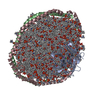
| |||||||||
|---|---|---|---|---|---|---|---|---|---|---|
| 1 |
| |||||||||
| NMR ensembles |
|
- Components
Components
| #1: Protein | Mass: 23131.346 Da / Num. of mol.: 1 / Fragment: residues 316-511 Source method: isolated from a genetically manipulated source Source: (gene. exp.)  Homo sapiens (human) / Gene: MMP14 / Production host: Homo sapiens (human) / Gene: MMP14 / Production host:  References: UniProt: P50281, membrane-type matrix metalloproteinase-1 | ||||||
|---|---|---|---|---|---|---|---|
| #2: Protein | Mass: 24912.156 Da / Num. of mol.: 2 / Fragment: residues 79-267 Source method: isolated from a genetically manipulated source Source: (gene. exp.)  Homo sapiens (human) / Gene: APOA1 / Production host: Homo sapiens (human) / Gene: APOA1 / Production host:  #3: Chemical | ChemComp-PX4 / #4: Chemical | ChemComp-NA / | #5: Chemical | ChemComp-CL / | |
-Experimental details
-Experiment
| Experiment | Method: SOLUTION NMR | ||||||||||||||||||||||||
|---|---|---|---|---|---|---|---|---|---|---|---|---|---|---|---|---|---|---|---|---|---|---|---|---|---|
| NMR experiment |
|
- Sample preparation
Sample preparation
| Details | Type: solution Contents: 20 mM Tri-HCl, 300 mM NaCl, 0.02 % sodium azide, 93 % H2O, 7 % [U-100% 2H] D2O, 90 uM 2H, 13C, 15N MT1-MMP hemopexin-like domain, 180 uM MSP1D1, 14.4 mM PX4, 93% H2O/7% D2O Details: 300 mM NaCl was used to reduce affinity of the HPX domain to the nanodisc. NMR shaped tubes were used to obtain a better spectra Label: 2H, 13C, 15N / Solvent system: 93% H2O/7% D2O | ||||||||||||||||||||||||||||||||||||
|---|---|---|---|---|---|---|---|---|---|---|---|---|---|---|---|---|---|---|---|---|---|---|---|---|---|---|---|---|---|---|---|---|---|---|---|---|---|
| Sample |
| ||||||||||||||||||||||||||||||||||||
| Sample conditions | Details: MT1-MMP hemopexin-like domain along with the MSP1D1 and PX4 complex were suspended in a buffer containing 300 mM NaCl, 0.02% sodium azide, 93% water, 7% D2O, and 20 mM Tris pH 7.2 Ionic strength: 300 mM / Label: NMR Buffer / pH: 7.2 / Pressure: 1 atm / Temperature: 303 K |
-NMR measurement
| NMR spectrometer | Type: Bruker AVANCE III / Manufacturer: Bruker / Model: AVANCE III / Field strength: 800 MHz |
|---|
- Processing
Processing
| NMR software |
| ||||||||||||||||||||||||
|---|---|---|---|---|---|---|---|---|---|---|---|---|---|---|---|---|---|---|---|---|---|---|---|---|---|
| Refinement | Method: molecular dynamics / Software ordinal: 4 | ||||||||||||||||||||||||
| NMR representative | Selection criteria: lowest energy | ||||||||||||||||||||||||
| NMR ensemble | Conformer selection criteria: all calculated structures submitted Conformers calculated total number: 15 / Conformers submitted total number: 15 |
 Movie
Movie Controller
Controller



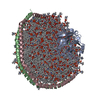


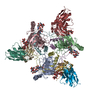

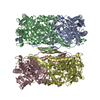
 PDBj
PDBj


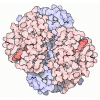









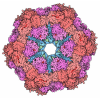




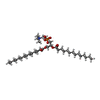





 NAMD
NAMD